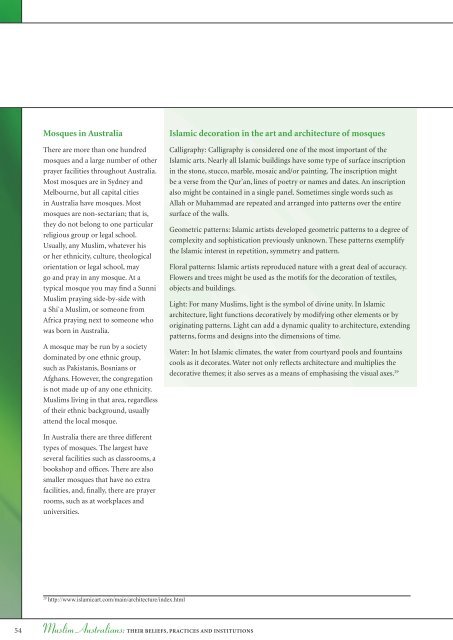Muslim Australians - Religion Cultural Diversity Resource Manual
http://www.islamicglobe.com
http://www.islamicglobe.com
You also want an ePaper? Increase the reach of your titles
YUMPU automatically turns print PDFs into web optimized ePapers that Google loves.
Mosques in Australia<br />
There are more than one hundred<br />
mosques and a large number of other<br />
prayer facilities throughout Australia.<br />
Most mosques are in Sydney and<br />
Melbourne, but all capital cities<br />
in Australia have mosques. Most<br />
mosques are non-sectarian; that is,<br />
they do not belong to one particular<br />
religious group or legal school.<br />
Usually, any <strong>Muslim</strong>, whatever his<br />
or her ethnicity, culture, theological<br />
orientation or legal school, may<br />
go and pray in any mosque. At a<br />
typical mosque you may find a Sunni<br />
<strong>Muslim</strong> praying side-by-side with<br />
a Shi`a <strong>Muslim</strong>, or someone from<br />
Africa praying next to someone who<br />
was born in Australia.<br />
A mosque may be run by a society<br />
dominated by one ethnic group,<br />
such as Pakistanis, Bosnians or<br />
Afghans. However, the congregation<br />
is not made up of any one ethnicity.<br />
<strong>Muslim</strong>s living in that area, regardless<br />
of their ethnic background, usually<br />
attend the local mosque.<br />
Islamic decoration in the art and architecture of mosques<br />
Calligraphy: Calligraphy is considered one of the most important of the<br />
Islamic arts. Nearly all Islamic buildings have some type of surface inscription<br />
in the stone, stucco, marble, mosaic and/or painting. The inscription might<br />
be a verse from the Qur’an, lines of poetry or names and dates. An inscription<br />
also might be contained in a single panel. Sometimes single words such as<br />
Allah or Muhammad are repeated and arranged into patterns over the entire<br />
surface of the walls.<br />
Geometric patterns: Islamic artists developed geometric patterns to a degree of<br />
complexity and sophistication previously unknown. These patterns exemplify<br />
the Islamic interest in repetition, symmetry and pattern.<br />
Floral patterns: Islamic artists reproduced nature with a great deal of accuracy.<br />
Flowers and trees might be used as the motifs for the decoration of textiles,<br />
objects and buildings.<br />
Light: For many <strong>Muslim</strong>s, light is the symbol of divine unity. In Islamic<br />
architecture, light functions decoratively by modifying other elements or by<br />
originating patterns. Light can add a dynamic quality to architecture, extending<br />
patterns, forms and designs into the dimensions of time.<br />
Water: In hot Islamic climates, the water from courtyard pools and fountains<br />
cools as it decorates. Water not only reflects architecture and multiplies the<br />
decorative themes; it also serves as a means of emphasising the visual axes. 29<br />
In Australia there are three different<br />
types of mosques. The largest have<br />
several facilities such as classrooms, a<br />
bookshop and offices. There are also<br />
smaller mosques that have no extra<br />
facilities, and, finally, there are prayer<br />
rooms, such as at workplaces and<br />
universities.<br />
29<br />
http://www.islamicart.com/main/architecture/index.html<br />
54 <strong>Muslim</strong> <strong>Australians</strong>:THEIR BELIEFS, PRACTICES AND INSTITUTIONS














